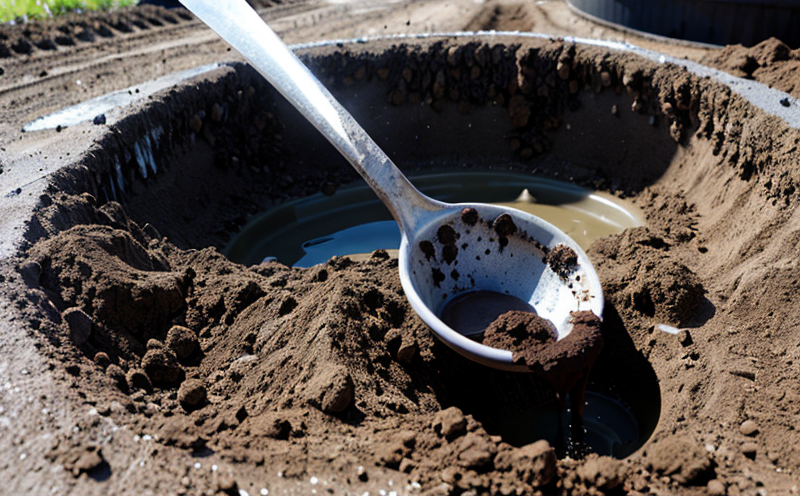EPA 8270 Semi Volatile Organic Compounds in Sludge Test
The EPA Method 8270 is a widely recognized standard protocol for analyzing semi-volatile organic compounds (SVOCs) in various matrices, including sludge and biosolids. This method plays a crucial role in environmental monitoring and compliance to ensure that wastewater treatment facilities adhere to stringent regulatory requirements set by the Environmental Protection Agency.
The SVOCs tested under EPA 8270 are a class of compounds with boiling points ranging from approximately 250°C to 400°C, which makes them resistant to vaporization at typical laboratory combustion temperatures. These compounds include pesticides, industrial solvents, and other chemicals that can persist in the environment for extended periods.
The testing procedure involves several critical steps: sample collection, extraction, derivatization (if necessary), clean-up, concentration, and finally, analysis by gas chromatography-mass spectrometry (GC-MS). The GC-MS is essential as it provides high sensitivity and selectivity required to detect trace levels of SVOCs in sludge.
The accuracy and precision of this method are paramount for reliable results. Therefore, strict adherence to the EPA 8270 protocol is necessary. This includes precise sample handling techniques to prevent contamination and degradation of the compounds being analyzed. Additionally, calibration standards must be accurately prepared and used throughout the analytical process.
The method’s robustness allows it to identify a wide array of SVOCs, which can help in understanding the environmental impact of wastewater treatment processes. By detecting these chemicals, facilities can take necessary actions to mitigate potential risks to public health and the environment. This testing is particularly important for land application or incineration of biosolids.
It’s essential to note that EPA 8270 ensures consistent results across different laboratories by standardizing methodologies and reagents used in the analysis. Compliance with this method not only helps facilities meet regulatory requirements but also enhances their reputation as responsible stewards of environmental resources.
The importance of accurate SVOC testing cannot be overstated, especially considering the long-term effects these chemicals can have on ecosystems. By employing EPA 8270 methodology, laboratories and wastewater treatment facilities contribute significantly to sustainable practices in water resource management.
Benefits
The implementation of EPA Method 8270 brings numerous benefits to various stakeholders involved in the wastewater and biosolids industry. For regulatory bodies, it ensures consistent compliance with environmental standards by providing reliable data on SVOCs present in sludge.
- Enhanced Regulatory Compliance: Ensures that all stakeholders are adhering to EPA regulations related to SVOCs in sludge.
- Precision and Reliability: Provides accurate results for the detection of trace levels of SVOCs, which is critical for environmental monitoring.
- Scientific Validation: Supports scientific research by providing a standardized method for testing SVOCs in sludge.
The benefits extend to wastewater treatment facilities as well. By using EPA 8270, these facilities can make informed decisions regarding the handling and disposal of biosolids, thereby reducing potential risks to public health and the environment.
For R&D engineers and quality managers within this sector, adopting EPA 8270 facilitates innovative approaches in wastewater treatment processes. It also aids in identifying areas where improvements are needed to enhance efficiency and effectiveness.
Industry Applications
- Wastewater Treatment Plants: Used to monitor SVOCs in biosolids intended for land application or incineration.
- Environmental Agencies: Employed by regulatory bodies to ensure compliance with environmental standards.
- Laboratories: Essential for providing accurate and reliable data to support various stakeholders involved in the industry.
The EPA 8270 methodology is critical for ensuring that all facilities handling biosolids are meeting stringent regulatory requirements. By adhering to this standard, wastewater treatment plants can demonstrate their commitment to environmental sustainability while also safeguarding public health.
Environmental agencies benefit from the precision and reliability of EPA 8270 as it provides consistent data across different laboratories. This facilitates more accurate assessments of SVOC levels in biosolids, helping to inform policy decisions and enforcement actions where necessary.
Laboratories that conduct this testing play a vital role by providing high-quality data that supports regulatory compliance and scientific research. They also ensure that facilities handling biosolids are adhering to best practices for environmental stewardship.
Customer Impact and Satisfaction
The adoption of EPA 8270 has a significant positive impact on customer satisfaction within the wastewater treatment industry. By ensuring compliance with regulatory requirements, facilities can enhance their reputation as responsible stewards of environmental resources.
- Increased Confidence: Customers gain confidence in the reliability and accuracy of the testing results provided by laboratories adhering to EPA 8270.
- Better Decision-Making: Regulatory bodies can make more informed decisions regarding wastewater treatment facilities, leading to better overall management practices.
The precision and reliability of EPA 8270 contribute to enhanced customer satisfaction by ensuring that all stakeholders involved in the industry are meeting stringent regulatory requirements. This not only improves compliance but also supports scientific research and environmental sustainability efforts.
By demonstrating their commitment to environmental stewardship through accurate testing, facilities can build stronger relationships with customers and regulatory bodies alike. This ultimately leads to higher levels of customer satisfaction across the board.





